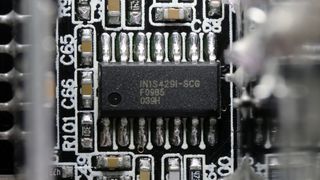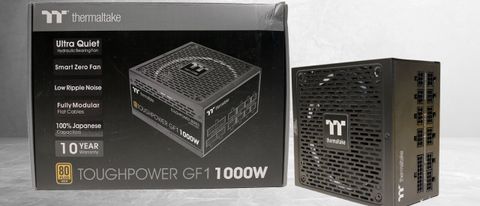Tom's Hardware Verdict
The Thermaltake Toughpower GF1 1000W does not pose a threat to other high-end, similar capacity units. Its build quality is high, but this is not enough to intimidate the competition.
Pros
- +
+ Full power at 47 degrees Celsius
- +
+ Good build quality
- +
+ Tight load regulation at 12V
- +
+ Good ripple suppression
- +
+ Longer than 17ms hold-up time
- +
+ Low inrush currents
- +
+ Not noisy at normal operating conditions
- +
+ Fully modular
- +
+ Adequate number of connectors
- +
+ Compatible with the alternative sleep mode
- +
+ 10-year warranty
Cons
- -
Mediocre transient response
- -
EMI filter needs tuning
- -
Overall efficiency needs a boost
- -
Low Power Factor readings
- -
Increased noise under stressful conditions
- -
High OCP on the minor rails
Why you can trust Tom's Hardware
The Thermaltake Toughpower GF1 1000W uses a reliable CWT platform, and its build quality is high. Nonetheless, that's not enough for this category, where the competition is so tough. Hence, its relative performance isn't so high, with a notable drop from what you'll find on lead units like the Corsair RM1000x (2021) and the EVGA SuperNOVA 1000 G6. This means that there is no chance for the GF1 1000W to take a spot in our best PSUs list.
Thermaltake's Toughpower GF1 line consists of five models with capacities ranging from 750W to 1200W. All are fully modular and Gold certified by 80 Plus and Cybenetics. The OEM is Channel Well Technology, which is quite popular in the mid and high-end PSU categories.












The GF1 1000W has enough power for a high-end gaming system and enough cables and connectors to transfer all this power smoothly. Its dimensions are normal, with 160mm depth, although PSUs like the EVGA SuperNOVA 1000 G6 are even smaller with 20mm less depth. We are not fans of PSU downsizing, though, since the smaller the PCB, the tougher it is to control the thermal loads and keep the fan's operation in the quiet zones. Speaking of the fan, the GF1 uses a hydraulic bearing fan, driven by an aggressive speed profile, so it can get loud under high loads.









Specifications
|
Manufacturer (OEM) |
CWT |
|
Max. DC Output |
1000W |
|
Efficiency |
80 PLUS Gold, Cybenetics Gold (87-89%) |
|
Noise |
Cybenetics S+ (35-40 dB[A]) |
|
Modular |
✓ (fully) |
|
Intel C6/C7 Power State Support |
✓ |
|
Operating Temperature (Continuous Full Load) |
0 - 50°C |
|
Over Voltage Protection |
✓ |
|
Under Voltage Protection |
✓ |
|
Over Power Protection |
✓ |
|
Over Current (+12V) Protection |
✓ |
|
Over Temperature Protection |
✓ |
|
Short Circuit Protection |
✓ |
|
Surge Protection |
✓ |
|
Inrush Current Protection |
✓ |
|
Fan Failure Protection |
✗ |
|
No Load Operation |
✓ |
|
Cooling |
140mm Hydraulic Bearing Fan [TT-1425 (A1425L12S)] |
|
Semi-Passive Operation |
✓ (selectable) |
|
Dimensions (W x H x D) |
150 x 85 x 160mm |
|
Weight |
1.97 kg (3.92 lb) |
|
Form Factor |
ATX12V v2.53, EPS 2.92 |
|
Warranty |
10 Years |
Power Specifications
| Rail | 3.3V | 5V | 12V | 5VSB | -12V | |
|---|---|---|---|---|---|---|
| Max. Power | Amps | 24 | 24 | 83.3 | 3 | 0.5 |
| Watts | 120 | 1000 | 15 | 6 | ||
| Total Max. Power (W) | 1000 |
Cables & Connectors
| Description | Cable Count | Connector Count (Total) | Gauge | In Cable Capacitors |
|---|---|---|---|---|
| ATX connector 20+4 pin (600mm) | 1 | 1 | 16AWG | No |
| 8 pin EPS12V (700mm) | 1 | 1 | 16AWG | No |
| 4+4 pin EPS12V (700mm) | 1 | 1 | 16AWG | No |
| 6+2 pin PCIe (500mm+150mm) | 3 | 6 | 16-18AWG | No |
| SATA (500mm+150mm+150mm+150mm) | 3 | 12 | 18AWG | No |
| 4-pin Molex (500mm+150mm+150mm+150mm) | 1 | 4 | 18AWG | No |
| FDD Adapter (150mm) | 1 | 1 | 20AWG | No |
| AC Power Cord (1420mm) - C13 coupler | 1 | 1 | 14AWG | - |
This PSU comes with plenty of cables and connectors, including two EPS, six PCIe, twelve SATA, and four 4-pin Molex connectors. There is even an FDD adapter in the bundle for those of you who still need one.
Cable length is satisfactory, and the distance between the peripheral connectors is ideal, at 150mm. Lastly, there are no in-cable caps, and the ATX, EPS, and PCIe cables up to the first connector use thicker 16AWG gauges.






Component Analysis
We strongly encourage those unfamiliar with PSU terminology to read our PSUs 101 article alongside this review. This article provides valuable information about PSUs and their operation, allowing you to better understand the components we're about to discuss.
| General Data | - |
| Manufacturer (OEM) | CWT |
| PCB Type | Double Sided |
| Primary Side | - |
| Transient Filter | 4x Y caps, 2x X caps, 2x CM chokes, 1x MOV, 1x CAP200DG (Discharge IC) |
| Inrush Protection | NTC Thermistor SCK-055 (5 Ohm) & Relay |
| Bridge Rectifier(s) | 2x GBU1510 (1000V, 15A @ 100°C) |
| APFC MOSFETs | 3x Infineon IPA50R140CP (500V, 15A @ 100°C, Rds(on): 0.14 Ohm) |
| APFC Boost Diode | 1x Infineon IDH10G65C6 (650V, 10A @ 140°C) |
| Bulk Cap(s) | 2x Nichicon (400V, 680uF & 470uF each or 1.150uF compined, 2,000h @ 105°C, GG) |
| Main Switchers | 2x Infineon IPW60R125P6 (600V, 19A @ 100°C, Rds(on): 0.125Ohm) |
| APFC Controller | Champion CM6500UNX & Champion CM03X |
| Resonant Controller | Champion CM6901X |
| Topology | Primary side: APFC, Half-Bridge & LLC converter Secondary side: Synchronous Rectification & DC-DC converters |
| Secondary Side | - |
| +12V MOSFETs | 8x International Rectifier IRFH7004PbF (40V, 164A @ 100°C, Rds(on): 1.4mOhm) |
| 5V & 3.3V | DC-DC Converters: 4x UBIQ QM3054M6 (30V, 61A @ 100°C, Rds(on): 4.8mOhm) & 2x UBIQ QN3107M6N (30V, 70A @ 100°C, Rds(on): 2.6mOhm) PWM Controllers: UPI Semi uP3861P |
| Filtering Capacitors | Electrolytic: 10x Nippon Chemi-Con (4-10,000h @ 105°C, KY), 6x Nichicon (4-10,000h @ 105°C, HE), 1x Rubycon (6-10,000h @ 105°C, ZLH), 1x Rubycon (3-6,000h @ 105°C, YXG) Polymer: 10x FPCAP, 11x NIC, 5x Nippon Chemi-Con |
| Supervisor IC | IN1S429I (OCP, OVP, UVP, SCP, PG) |
| Fan Model | Thermaltake TT-1425 (Hong Sheng A1425L12S) (140mm, 12V, 0.30A, Hydraulic Bearing Fan) |
| 5VSB Circuit | - |
| Rectifier | 1x Galaxy Microelectronics D10PS45L SBR (45V, 10A) & IPS ISD04N65A FET |
| Standby PWM Controller | On-Bright OB5282 |

PCB Top



The ToughPower GF1 1000W uses CWT's GPR platform, which is quite good. This platform uses a half-bridge topology on the primary side and an LLC resonant converter for increased efficiency. We also saw a synchronous rectification scheme for 12V and two DC-DC converters for the minor rails on the secondary side. Soldering quality is good, and the parts that CWT uses are also good.






The transient/EMI filtering stage includes all necessary parts. We also found a discharge IC to restrict energy losses on a bleeding resistor.


The pair of bridge rectifiers can handle up to 30A of current.



The APFC converter uses three Infineon FETs and a single boost diode provided by the same OEM. The bulk caps are by Nichicon, and their combined capacity is 1150uF, so we expect a higher than 17ms hold-up time. The APFC controller is a Champion CM6500UNX, supported by a CM03X for increased efficiency at standby.




The main FETs are by Infineon, and they are arranged into a half-bridge topology. The resonant controller is a Champion CM6901X IC, which is widely used nowadays.




The eight FETs that regulate the 12V rail are installed on a daughter-board, right beside the main transformer.





The filtering caps are provided by Chemicon, Nichicon, Rubycon, FPCAP, and NIC. All good brands.



The standby PWM controller is an On-Bright OB5282. On the primary side of the standby rectifier, we found an ISD04N65A FET, and on the secondary side, a D10PS45L SBR.



Several polymer caps are installed on the modular board, providing an extra ripple filtering layer.

The main supervisor IC is an IN1S429I IC, providing the basic protection features with only OTP missing. The latter is implemented through another circuit.



There aren't many things to see on the solder side of the PCB. Nonetheless, the soldering quality is strong.


The cooling fan is by Hong Sheng, but it bears TT's logo. It uses a hydraulic bearing so that it won't make much noise, and it will last for a long time if it doesn't operate under very high temperatures (>40 Centigrade) for prolonged periods.
MORE: Best Power Supplies
MORE: How We Test Power Supplies
MORE: All Power Supply Content
Current page: Specifications and Part Analysis
Next Page Load Regulation, Hold-Up Time, Inrush & Leakage Current, Efficiency and NoiseAris Mpitziopoulos is a Contributing Editor at Tom's Hardware US, covering PSUs.
